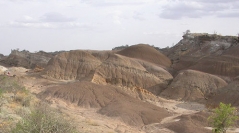

 Comptes Rendus Palevol
13 (8) - Pages 737-746
Comptes Rendus Palevol
13 (8) - Pages 737-746The spatial relationships of the Early Oldowan toolmakers with their environment have been so far addressed through raw material procurement analyses and the characterization of hominid habitat. This paper proposes to integrate these two approaches into a broader spatial analysis encompassing archaeological and environmental data (palaeontological, geological and isotopic data) from Member F and lower Member G of the Shungura Formation (Lower Omo Valley, Ethiopia). Heterogeneity in data resolution induces a multiscale approach with three levels of analysis. The level of occurrence complex allows focusing on the characterization of archaeological occurrences and on their environmental settings. The level of “study area” allows working on hominid habitats and on their raw material procurement behaviours. Finally, at the Shungura Formation scale, we can address temporal issues related to the evolution of spatial behaviours between Member F and the lower part of Member G, ca. 2.3 to 2 million years (Ma).
Early Oldowan, Spatial behaviours, Environment, Stone tools, Eastern Africa, Lower Pleistocene, Shungura Formation